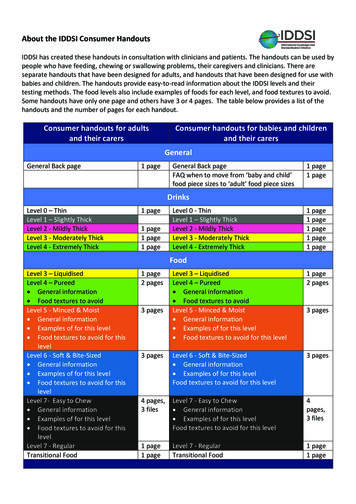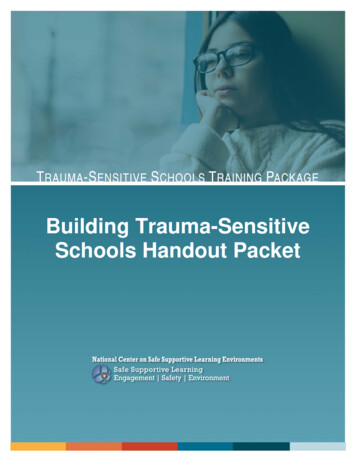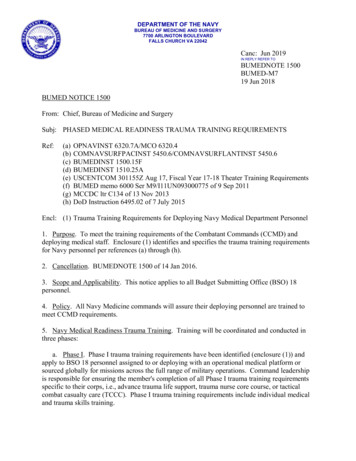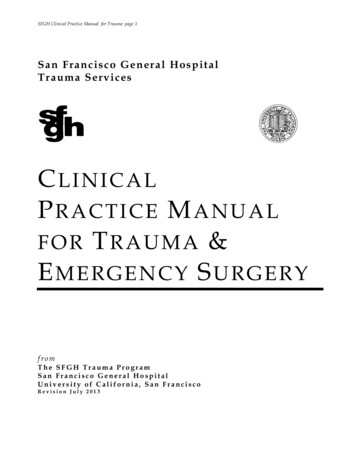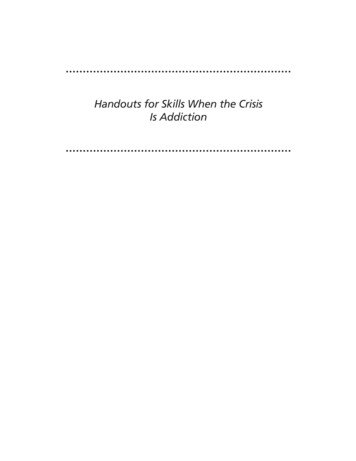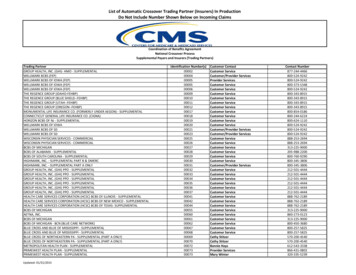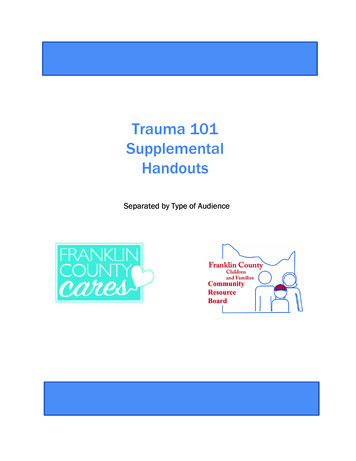
Transcription
Trauma 101SupplementalHandoutsSeparated by Type of Audience
FLARESThe Franklin County CommunityResourceBoard(FCCRB)Families LearningAbout RecoveryStrategiesisdedicated to creating a System ofCarefortheChildrenandFamilies of Franklin County,Missouri.FortheFLARESproject, we decided to put ourpowers together with FranklinCounty agencies to help thewholefamilylearnhowtorecover from trauma.Franklin CountyCommunity ResourceBoard501 West End Avenue,Union, MO 63084(636) 234-7133www.franklincountykids.orgCaregivers and theirchildren working totogether toovercome trauma.Franklin County CommunityResource Board
The FLARES Model:What is FLARES?The aim of the FLARES project is tobetter serve families who areimpacted by the experience oftrauma thru working with the entirefamily. Our hope is that traumatherapy will be even more effectiveif we first help caregivers workthrough their own trauma so theycan better support their child. EachFLARES family will have an adult anda child therapist working with them.Caregivers in the FLARES projectwill receive Cognitive ProcessingTherapy (CPT), an evidence-basedtherapy that is effective inreducing symptoms of trauma.Children in FLARES will receiveTrauma-Focused CognitiveBehavioral Therapy (TF-CBT),which has also shown to helpchildren overcome the impact oftrauma. Caregivers first learn howto cope with their own distressrelated to trauma and how to bestsupport their child’s recovery.FLARES families will receivecoordinated trauma-focusedtreatment that will work to helpfamilies heal.Is FLARES right for us?The FLARES program is forcaregivers and children whohave both experiencedtrauma and are bothstruggling to overcome itsimpact.The FLARES verfinishestherapy!6FamilyfinishesFLARES!
Personal Supportfor You!Behavioral Health Response introduces myStrengthWe all have our struggles.Finding support to focus on your emotional health is important.Now you can use web and mobile toolsto help you get better and stay mentally strong.myStrength is safe and secure—just for you. It offers personalized resourcesto improve your mood. Learning to use myStrength’s resources can helpyou overcome the challenges you face.What myStrengthusers are saying‘‘It’s nice to haveself-guided help that isso accessible.myStrength gives backsome of the ‘light’I had lost.‘‘myStrength gives mehope and inspirationfor my recovery.myStrength’s proven tools can help strengthen yourmind, body and spirit.SIGN UP TODAY1. Go to www.mystrength.com2. Click Sign Up3. Enter the Access Code: BHRCommunity 2016 myStrength, Inc. All rights reserved.FPF-SAC2-BHR-1216
TRAUMA WHEEL
What is Traumatic Stress?Many children experience traumatic events. Some of these experiences happen once in child’slifetime, whereas others are re-occurring. A significant number of children have experiencedmultiple traumatic events.The National Child Abuse and Neglect Data Systems (NCANDS) glossary in Child Maltreatment index.htm) provides the backbone to thefollowing categories of traumatic stress provided by the National Child Traumatic Stress Network(Core Clinical Characteristics form dated 9/2007):Sexual Maltreatment/AbuseNote: Sexual maltreatment/abuse refers to acts by an adult or older youth who is playing acaretaker role for the youth (e.g., parent, parent-substitute, babysitter, adult relative, teacher, etc.).Sexual contact/exposure by others (i.e., non-caretakers) should be classified as ‘sexualassault/rape.’ Actual or attempted sexual contact (e.g., fondling; genital contact; penetration, etc.) and/orexposure to age-in-appropriate sexual material or environments (e.g., print, internet orbroadcast pornography; witnessing of adult sexual activity) by an adult to a minor child. Sexual exploitation of a minor child by an adult for the sexual gratification or financial benefitof the perpetrator (e.g., prostitution; pornography; orchestration of sexual contact betweentwo or more minor children). Unwanted or coercive sexual contact or exposure between two or more minor children.Sexual Assault/RapeNote: Sexual assault/rape should include contact/exposure by perpetrators who are NOT in acaretaking role with the youth (sexual misconduct by caregivers should be recorded as ‘sexualmaltreatment/abuse.’) Actual or attempted sexual contact (e.g., fondling; genital contact; penetration, etc.) and/orexposure to age-inappropriate sexual material or environments (e.g., print, internet orbroadcast pornography; witnessing of adult sexual activity) by an adult to a minor child. Sexual exploitation of a minor child by an adult for the sexual gratification or financial benefitof the perpetrator (e.g., prostitution; pornography; orchestration of sexual contact betweentwo or more minor children). Unwanted or coercive sexual contact or exposure between two or more minors.Physical Abuse/MaltreatmentNote: Physical abuse/maltreatment refers to acts by an adult or older youth who is playing acaretaker role for the youth (e.g., parent, parent-substitute, babysitter, adult relative, teacher, etc.).Physical pain and/or injury by others (i.e., non-caretakers) should be classified as ‘physical assault.’ Actual or attempted infliction of physical pain (e.g., stabbings; bruising; burns; suffocation.)by an adult, another child, or group of children to a minor child with or without use of anobject or weapon and including use of severe corporeal punishment. Does not include rough and tumble play or developmentally normative fighting betweensiblings or peers of similar age and physical capacity (e.g., assault of a physically disabledchild by a non-disabled same-aged peer would be included in this category of traumaexposure).Worksheet downloaded from http://www.TAPTraining.netPage 1 of 4
Physical AssaultNote: Physical assault should include infliction of physical pain/bodily injury by perpetrators who arenot in a caretaking role with the youth (such actions by caregivers should be recorded as ‘physicalmaltreatment/abuse’). Actual or attempted infliction of physical pain (e.g., stabbings; bruising; burns; suffocation.)by an adult, another child, or group of children to a minor child with or without use of anobject or weapon and including use of severe corporeal punishment. Does not include rough and tumble play or developmentally normative fighting betweensiblings or peers of similar age and physical capacity (e.g., assault of a physically disabledchild by a non-disabled same-aged peer would be included in this category of traumaexposure).Emotional Abuse/Psychological Maltreatment Acts of commission against a minor child, other than physical or sexual abuse, that caused orcould have caused conduct, cognitive, affective, or other mental disturbance. These actsinclude: Verbal abuse (e.g., insults; debasement; threats of violence). Emotional abuse (e.g., bullying; terrorizing; coercive control). Excessive demands on a child’s performance (e.g., scholastic; athletic; musical;pageantry) that may lead to negative self-image and disturbed behavior. Acts of omission against a minor child that caused or could have caused conduct, cognitive,affective or other mental disturbance. These include: Emotional neglect (e.g., shunning; withdrawal of love). Intentional social deprivation (e.g., isolation; enforced separation from a parent,caregiver, or other close family member).Neglect Failure by the child victim’s caretaker(s) to provide needed, age-appropriate care althoughfinancially able to do so, or offered financial or other means to do so. Includes: Physical neglect (e.g., deprivation of food, clothing, shelter). Medical neglect (e.g., failure to provide child victim with access to needed medical ormental health treatments and services; failure to consistently disperse or administerprescribed medications or treatments (e.g., insulin shots)). Educational neglect (e.g., withholding child victim from school; failure to attend tospecial educational needs; truancy).Domestic Violence Exposure to emotional abuse, actual/attempted physical or sexual assault, or aggressivecontrol perpetrated between a parent/caretaker and another adult in the child victim’s homeenvironment. Exposure to any of the above acts of perpetrated by an adolescent against one or moreadults (e.g., parents, grandparent) in the child victim’s home environment.War/Terrorism/Political Violence Inside the U.S. Exposure to acts of war/terrorism/political violence on U.S. soil (including Puerto Rico).Historical examples include attacks of 9-11, Oklahoma bombing, and anthrax deaths. Includes actions of individuals acting in isolation, e.g. sniper attacks, school shootings if theyare considered to be political in nature.War/Terrorism/ Political Violence Outside the U.S. Exposure to acts of war/terrorism/political violence, including living in a region affected bybombing, shooting, or looting other than in the U.S. Accidents that are a result of terrorist activity (e.g., bridge collapsing due to intentionaldamage, hostages who are injured during captivity) outside the U.S.Worksheet downloaded from http://www.TAPTraining.netPage 2 of 4
Illness/Medical Having a physical illness or experiencing medical procedures that are extremely painfuland/or life-threatening. The event of being told that one has a serious illness. Examples of illnesses include cancer or AIDS. Examples of medical procedures includechanging burn dressings or undergoing chemotherapy. Does NOT include medical injuries that would otherwise be classified under Injury/accident(e.g., a child who is burned in a fire would be designated as experiencing an accident/injurytrauma; however, if they then had to undergo repeated, painful dressing changes they wouldalso qualify for illness/medical trauma).Injury/Accident Injury or accident such as car accident, house fire, serious playground injury, or accidentalfall down stairs. Does NOT include injury or accident caused at the hands of another person who is intendingharm of any type (e.g. a child who falls down the stairs after a parent pushes him would beclassified under physical maltreatment/assault, even if the parent didn’t intend for the pushto lead to the fall). Key concept here is “Unintentional.”Natural Disaster Major accident or disaster that is an unintentional result of manmade or natural event, e.g.tornado, nuclear reactor explosion. Does NOT include disasters that are intentionally caused (e.g., Oklahoma City Bombing,bridge collapsing due to intentional damage), which would be classified as acts ofterrorism/political violence.Kidnapping Unlawful seizure or detention against the child’s will. May include kidnapping by non-custodial parent as well as by stranger.Traumatic Loss or Bereavement Death of a parent, primary caretaker or sibling. Abrupt, unexpected, accidental, or premature death or homicide of a close friend, familymember, or other close relative. Abrupt, unexplained and/or indefinite separation from a parent, primary caretaker, or sibling,due to circumstances beyond the child victim’s control (e.g., contentious divorce; parentalincarceration; parental hospitalization; foster care placement).Forced Displacement Forced relocation to a new home due to political reasons. Generally includes political asyleesor immigrants fleeing political persecution. Refugees or political asylees who were forced tomove and were exposed to war may be classified here and also under war/terrorism/politicalviolence outside U.S. Does NOT include immigrants who move voluntarily (e.g., moving due to poverty of homecountry), or families who are evicted. Does NOT include homelessness. The key concept here is “Political.”Worksheet downloaded from http://www.TAPTraining.netPage 3 of 4
Impaired Caregiver Functional impairment in at least one of child’s primary caregivers that results in deficientperformance of the caretaking role (i.e., inability to meet the child’s needs). Impairment means that caregiver(s) were neither able to provide children with adequatenurturance, guidance, and support nor attend to their basic developmental needs due to theirown mental illness, substance abuse, criminal activity, or chronic overexposure to severe lifestressors (e.g., extreme poverty, community violence). Impairment may be due to various causes (e.g., medical illness, mental illness, substanceuse/abuse, exposure to severance life stressors (e.g., extreme poverty, community violence)) If impairment results in additional trauma (e.g., neglect, emotional abuse/psychologicalmaltreatment), BOTH ‘impaired caregiver’ and the more specific type of trauma should bereported.Extreme Personal/Interpersonal Violence (not reported elsewhere) Includes extreme violence by or between individuals that has not been reported elsewhere(hence, if the child witnessed domestic violence, this should be recorded as “domesticviolence” and NOT repeated here). Intended to include exposure to homicide, suicide and other similar extreme events.Community Violence (not reported elsewhere) This category is intended to capture episodic or pervasive violence in the youth’s communitythat have not been captured in other categories. Include extreme violence in the community (i.e., neighborhood violence) Exposure to gang-related violence should be recorded here (though specific incidents ofgang-related violence (e.g., homicide, assaults) should also be recorded under those morespecific headings.School Violence This category is intended to capture violence that occurs in the school setting and that hasnot been reported in other categories. It includes, but is not limited to: school shootings, bullying, interpersonal violence amongclassmates, and classmate suicide.Worksheet downloaded from http://www.TAPTraining.netPage 4 of 4
Coping with Trauma RemindersWhat are trauma reminders?Many children in the child welfare system have been through multiple traumatic events, often at thehands of those they trusted to take care of them. When faced with people, situations, places, or thingsthat remind them of these events, children may re-experience the intense and disturbing feelings tiedto the original trauma. These “trauma reminders” can lead to behaviors that seem out of place in thecurrent situation, but were appropriate—and perhaps even helpful—at the time of the original traumaticevent. For example:nA seven-year-old boy whose father and older brother fought physically in front of him becomesfrantic and tries to separate classmates playfully wrestling on the schoolyard.nA three-year-old girl who witnessed her father beating her mother clings to her resource mother,crying hysterically when her resource parents have a mild dispute in front of her.nA nine-year-old girl who was repeatedly abused in the basement of a family friend’s houserefuses to enter the resource family’s basement playroom.nA toddler who saw her cousin lying in a pool of blood after a drive-by shooting has a tantrum aftera bottle of catsup spills on the kitchen floor.nA teenager who was abused by her stepfather refuses to go to gym class after meeting the newgym teacher who wears the same aftershave as her stepfather.nA twelve-year-old boy who’d been molested by a man in a Santa Claus suit runs screaming out ofa YMCA Christmas party.What happens when a child responds to a trauma reminder?When faced with a trauma reminder, children may feel frightened, jumpy, angry, or shut down. Theirhearts may pound or they may freeze in their tracks, just as one might do when confronting an immediatedanger. Or they may experience physical symptoms such as nausea or dizziness. They may feelinexplicably guilty or ashamed or experience a sense of dissociation, as if they are in a dream or outsidetheir own bodies.Children’s reactions may vary somewhat by age. Preschool children may:nFeel vulnerable and helplessnReact very literally and dramatically (e.g., flinching, crying, trying to hide) to concrete reminderssuch as a raised hand or a facial expressionnExhibit sudden strong emotional outbursts or tantrumsnHave little memory of the traumatic events that they can put into wordsnAct out the traumatic events in playChild Welfare Trauma Training Toolkit: Trauma Reminders January 2013The National Child Traumatic Stress Networkwww.NCTSN.org
School-aged children may:nExhibit physical symptoms, such as stomachaches or headachesnVacillate between being withdrawn and quiet or aggressive and noisyTeenagers may:nRespond recklessly, taking more risks or abusing substancesnLimit themselves or withdraw from activities to avoid remindersnFear that their strong reactions mean they are “going crazy”nFeel stigmatized by having gone through traumatic events and may not feel that they can talkabout themSometimes children are aware of their reaction and its connection to the original event. More often,however, they are unaware of the root cause of their feelings and may even feel frightened by theintensity of their reaction.How can I help?Children who have experienced trauma may face so many trauma reminders in the course of an ordinaryday that the whole world seems dangerous, and no adult seems deserving of trust. Child welfare workersare in a unique position to help these children recognize safety and begin to trust adults who do indeeddeserve their trust.It’s very difficult for children in the midst of a reaction to a trauma reminder to calm themselves,especially if they do not understand why they are experiencing such intense feelings. Despitereassurance, these children may be convinced that danger is imminent or that the “bad thing” is aboutto happen again. It is therefore critical to create as safe an environment as possible. Children who haveexperienced trauma need repeated reassurances of their safety. When a child is experiencing a traumareminder, it is important to state very clearly and specifically the reasons why the child is now safe. Eachtime a child copes with a trauma reminder and learns once more that he/she is finally safe, the worldbecomes a little less dangerous, and other people a little more reliable.Tips for Helping Children Identify and Cope With Trauma RemindersnLearn as many specifics as you can of what the child experienced so that you can identifywhen the child is reacting to a reminder. Look for patterns (time of day, month, season, activity,location, sounds, sights, smells) that will help you understand when the child is reacting. Helpthe child to recognize these trauma reminders. Sometimes just realizing where a feeling camefrom can help to minimize its intensity.Child Welfare Trauma Training Toolkit: Trauma Reminders January 2013The National Child Traumatic Stress Networkwww.NCTSN.org
nDo not force the child into situations that seem to cause unbearable distress. Allow the child toavoid the most intense reminders, at least initially, until he or she feels safe and trusts you.nWhen the child is reacting to a reminder, help him or her to discriminate between pastexperiences and the present one. Calmly point out all the ways in which the current situation isdifferent from the past. Part of the way children learn to overcome their powerful responses isby distinguishing between the past and the present. They learn, on both an emotional (feeling)and cognitive (thinking and understanding) level, that the new experience is different from the oldone.nProvide tools to manage emotional and physical reactions. Deep breathing, meditation, or othertechniques may help a child to manage emotional and physical reactions to reminders. If you areunfamiliar with such techniques, ask a counselor to help.nRecognize the seriousness of what the child went through, and empathize with his or herfeelings. Don’t be surprised or impatient if the child continues to react to reminders weeks,months, or even years after the events. Help the child to recognize that reactions to traumareminders are normal and not a sign of being out of control, crazy, or weak. Shame aboutreactions can make the experience worse.nAnticipate that anniversaries of events, holidays, and birthdays may serve as reminders.nWith the child, identify ways that you can best reassure and comfort during a trauma reminder.These might be a look of support, a reassurance of safety, words of comfort, a physical gesture,or help in distinguishing between the present and the past.nSeek professional help if the child’s distress is extreme, or if avoidance of trauma reminders isseriously limiting your child’s life or movement forward.nBe self-aware. A child’s reaction to a trauma reminder may serve to remind you of something badthat happened in your own past. Work to separate your own reactions from those of the child.For more information on the impact of trauma on children,visit the National Child Traumatic Stress Network (NCTSN) at www.NCTSN.org.Child Welfare Trauma Training Toolkit: Trauma Reminders January 2013The National Child Traumatic Stress Networkwww.NCTSN.org
Child Welfare Trauma Referral Tool (CWT)(Nicole Taylor, Charles Wilson, & Alan Steinberg, 2006)This measure is designed to help child welfare workers make more trauma-informeddecisions about the need for referral to trauma-specific and general mental health services.It is to be completed by the child welfare worker through record review and key informants(i.e., natural parent, foster parent, child therapist, school-aged children or adolescents ifappropriate, and other significant individuals in the child’s life).Section A allows the child welfare worker to document history of exposure to a variety oftypes of trauma and indicate the age range over which the child experienced each trauma.Section B allows the child welfare worker to document the severity of the child’s traumaticstress reactions. Section C allows the child welfare worker to document attachmentproblems. Section D allows the child welfare worker to document behaviors requiringimmediate stabilization. Section E allows the child welfare worker to document the severityof the child’s other reactions/behaviors/functioning. Section F provides strategies for makingrecommendations to general or trauma-specific mental health services by linking the child’sexperiences to their reactions.To obtain permission to use the Child Welfare Trauma Referral Tool, please contact LisaConradi, at lconradi@rchsd.org or 858-576-1700, ext. 6008.Child Welfare Trauma Training Toolkit: Child Welfare Trauma Referral Tool (CWT)Revised, January 2013The National Child Traumatic Stress Networkwww.NCTSN.org
Change in Placement (Specify):nnNew Trauma ReportedAge:nnOther (Specify):Problematic Reactions/Behaviors ReportedNumber of Months in Current Placement:Date:nnnnnnnnSuicidal IdeationActive Substance AbuseEating DisorderSerious Sleep DisorderDisturbance in the patient's amount of sleep, quality or timing of sleep, or in behaviors orphysiological conditions associated with sleep.Any of several psychological disorders (as anorexia nervosa or bulimia) characterized byserious disturbances of eating behavior.An unhealthy pattern of substance (alcohol or drug) use that results in significant problems inone of the following ways: (1) An inability to adequately take care of your responsibilities or fillyour role at work, school, or home; (2) The frequent use of substances in situations where itmight be dangerous to do so (for example, driving while under the influence); (3) Repeated legalproblems due to substance use (for example, public intoxication or disorderly conduct); and(4) The continued use of substances even though the substance use is causing considerableproblems in your life.Thinking about, considering, or planning for suicide.How to Recognize Problem Behaviors:(Check Yes if child presents with any of the descriptors listed below)Child Welfare Trauma Training Toolkit: Child Welfare Trauma Referral Tool (CWT) Revised, January 2013The National Child Traumatic Stress Networkwww.NCTSN.orgnnnnNo SuspectedYesA. Behaviors Requiring Immediate Stabilization (Refer to Flow Chart for Specific Referrals for each type of problem)Baseline Assessment: New clientnReason for Current Evaluation (check all that apply):Child’s Name:Form Completed by (Name/Title/ID Code):
nnnnnnnnnnnnAffect DysregulationAnxietyAttachment DifficultiesAttention/ ConcentrationConduct ProblemsDepressionDepressed children may appear tearful/sad, show decreased interest in previousactivities, have difficulty concentrating, or display irritability, They may present withdepressed mood, social withdrawal, sleep disturbances, weight/eating disturbances,loss of motivation, verbal aggression, sullenness, grouchiness, hopelessness, ornegativity. They may have frequent complaints of physical problems.Defined by a variety of different conduct problems. Child may be physically orverbally aggressive to other people or animals. Children with conduct problems maydestroy property, steal, break the law, or start fires. They may run away from homeor act in a sexually promiscuous or aggressive fashion.Children with problems with attention, concentration and task completion often havedifficulty completing schoolwork or may have difficulty forming strong peer relationships.This category refers to a child’s difficulty forming or maintaining relationships with significantparental or caregiver figures. It relates to the child’s sense of security and trust in interactingwith others. Often children with attachment difficulties interact with new acquaintancesin unusual ways. They may bond too quickly (e.g., hugging strangers and climbing on theirlaps), or fail to engage in appropriate ways (e.g., avoid eye contact and fail to engage inappropriate conversations/interactions).Anxious children often appear tense or uptight. Worries may interfere with activities and theymay seek reassurance from others or be clingy. These children may be quiet, compliant andeager to please, so they may be overlooked. They may report phobias, panic symptoms, andreport physical complaints, startle easily, or have repetitive unwanted thoughts or actions.Children with affect dysregulation may have difficulty expressing specific feelings, whetherpositive or negative, and may have trouble fully engaging in activities. They may haveproblems modulating or expressing emotions, experience intense fear or helplessness, orhave difficulties regulating sleep/wake cycle.How to Recognize Problem Behaviors:(Check Yes if child presents with any of the descriptors listed below)Child Welfare Trauma Training Toolkit: Child Welfare Trauma Referral Tool (CWT) Revised, January 2013The National Child Traumatic Stress Networkwww.NCTSN.orgnnnnnnNo SuspectedYesDoes this interfere withchild’s daily functioningat home, school or inthe community?B. Current Reactions/Behaviors/Functioning
nnnnnnnnnnnnnnDissociationImpulsivityOppositional BehaviorsRegressionSomatizationSuicidal BehaviorSelf-HarmWhen someone deliberately harms him or herself. Includes cutting behaviors,punching oneself, pulling out hair or eyelashes, picking skin causing sores, burning,inhaling or overdosing on medications.Includes both superficial and more serious actions with potentially life-threateningconsequences. Examples include overdosing, deliberately crashing a car, or slashingwrists.Somatization is characterized by recurrent physical complaints without apparentphysical cause. Children may report stomachaches or headaches, or on the moreserious end of the spectrum, they may report blindness, pseudoseizures, or paralysis.Child ceases using previously adaptive behaviors. Child may begin wetting or soilingthemselves after they had been potty trained, and may begin using baby talk orrefusing to sleep alone when these skills were previously mastered.Defined by negativistic, hostile and defiant behaviors. Child may lose temperfrequently, argue with adults, and refuse to comply with adult rules. Child maydeliberately annoy people and blame others for mistakes or misbehaviors.Acting or speaking without first thinking of the consequences.Children experiencing dissociation may daydream frequently. They may seem tobe spacing out and be emotionally detached or numb. They are often forgetful andsometimes they experience rapid changes in personality often associated withtraumatic experiences.How to Recognize Problem Behaviors:(Check Yes if child presents with any of the descriptors listed below)Child Welfare Trauma Training Toolkit: Child Welfare Trauma Referral Tool (CWT) Revised, January 2013The National Child Traumatic Stress Networkwww.NCTSN.orgnnnnnnnNo SuspectedYesDoes this interfere withchild’s daily functioningat home, school or inthe community?
nnnnnnnnnnnnnnnnnnnnnnnnnnnnCommunity Violence ExposureDomestic Violence ExposureEmotional AbuseExtreme Personal/Interpersonal ViolenceExposureForced DisplacementNatural or Manmade DisastersNeglectPhysical Abuse or AssaultSchool Violence ExposureSerious Accident/Illness/Medical ProcedureSexual Abuse or Assault/RapeSystems-Induced TraumaTraumatic Grief/Separation (does not includeplacement in foster care)War/Terrorism/Political nnnnnnnnnnnnnnnnnnnnnnnnnnnnnnnnnnnnnnnnnnnnnn9 10 11 12 13 14 15 16 17 18 19 20Age(s) Experienced (Check each box as appropriate—example: sexual abusefrom ages 6–9 would check 6, 7, 8, and 9)Child Welfare Trauma Training Toolkit: Child Welfare Trauma Referral Tool (CWT) Revised, January 2013The National Child Traumatic Stress Networkwww.NCTSN.orgnnnnnnnnnnnnnnNo SuspectedYesTrauma Type(Definitions attached)C. Trauma/Loss Exposure History
nnnnnnnnRe-experiencingAvoidanceNumbingArousalThe
Educational neglect (e.g., withholding child victim from school; failure to attend to special educational needs; truancy). Domestic Violence Exposure to emotional abuse, actual/attempted physical or sexual assault, or aggressive control perpetrated between a parent/caretaker and another adult in the child victim's home environment.

